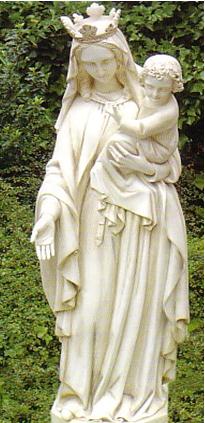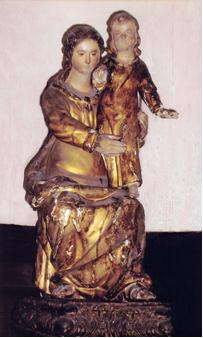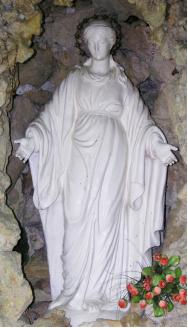It is a well-known fact that Fr. Noailles had great devotion to Our Lady. We are told that “he loved her as a son loves his mother”. “He had to see her everywhere and, if we did not know how great his devotion for her was, we would be astonished to see so many of her images around him”.
OUR LADY OF ALL GRACES
It is a well-known fact that Fr. Noailles had great devotion to Our Lady. We are told that “he loved her as a son loves his mother”. “He had to see her everywhere and, if we did not know how great his devotion for her was, we would be astonished to see so many of her images around him”. Mother Bonnat also tells us that although he addressed Mary under various titles, he summed them all up in the title “Our Lady of All Graces.”
Our Founder had at least three very deep experiences in reference to Our Lady even before he was ordained and we know that she continued to obtain graces for him throughout his life. As part of the rule of life which he wrote before leaving the Seminary of Saint-Sulpice in 1819, he composed a prayer in which he says to Our Lady, “Mary, my good Mother, it is to your tenderness that I owe all the favours that your Divine Son has granted me and of which I am so unworthy” showing us that he looked on her as the person who asked for graces for him and obtained them.
Fr. Noailles recommends us to do as he did, to sum up all Our Lady’s titles in this one. He says, for example,
It is very good and very advantageous to invoke Mary our blessed Mother under her different titles but it is a duty for the members of the Holy Family by what they do and what they say, to propagate trust in Mary under the name of Our Lady of All Graces.
He wrote his rules in front of the statue of Our Lady of All Graces on the island in Martillac stopping frequently to pray to her for guidance. Virginia Machet tells us that he often spent hours praying in front of the statue of Our Lady of All Graces in the grotto. Then, when he was too ill to go to the island, he had a replica of that statue made for his room so that he could continue to work in her presence, so to speak. We may think that the statue in the grotto is not that of Our Lady of All Graces. But it is. Our Lady was always Our Lady of All Graces for Fr. Noailles no matter what the statue looked like. In fact, the first statue of Our Lady of All Graces that he knew was in the chapel of Our Lady of All Graces in the grounds of Saint-Sulpice in Issy. There, Our Lady is seated and the Child Jesus is standing on her knee.
When the island was first blessed on 12 June (that is why the Holy Family celebrates the feast on that date) in 1844, the statue of Our Lady of All Graces which was there was the statue in the grotto.
Our Lady Our Lady
of All Graces, of All Graces,
Issy. The Grotto
 It was only later that our Founder thought it would be good to have a special statue of Our Lady of All Graces for the Association. So one day when he was in Martillac he asked the Sisters what kind of statue they would like – one with the baby or one without the baby. Among the group he asked were Suzanne and Virginia Machet, a mother and daughter who had both become Holy Family Sisters. The mother said that she would like a statue without the baby. The daughter was quite indignant and said that she of all people should know how important it was to have a baby. Fr. Noailles, we are told, had a good laugh; and so we have our own special statue of Our Lady with the baby, he inviting us to look at his mother while she presents her Son to us.
It was only later that our Founder thought it would be good to have a special statue of Our Lady of All Graces for the Association. So one day when he was in Martillac he asked the Sisters what kind of statue they would like – one with the baby or one without the baby. Among the group he asked were Suzanne and Virginia Machet, a mother and daughter who had both become Holy Family Sisters. The mother said that she would like a statue without the baby. The daughter was quite indignant and said that she of all people should know how important it was to have a baby. Fr. Noailles, we are told, had a good laugh; and so we have our own special statue of Our Lady with the baby, he inviting us to look at his mother while she presents her Son to us.
Our Founder did not go into any complicated theological explanations about what he meant by the title of Our Lady of All Graces. For him, she was simply a wonderful Mother to whom he went when he needed something, and she got it for him. He encourages us to ask for her help before God in all the circumstances of our lives and, especially in all the good works that we undertake for the glory of God in Jesus, Mary and Joseph. He actually used the gospel which was later chosen for the Mass of the feast—the Wedding Feast of Cana—to illustrate the way Mary asks Jesus for what we need, and receives it. One of the things he said in the homily on that gospel is that the power of Mary at that wedding celebration is the image of the power which she has today in heaven. So, let us often ask Our Lady, as Fr. Noailles did, to renew the miracle that she obtained from her Son at Cana; and “as he turned the water into wine may he turn our wayward hearts into hearts burning with love for him and for her.”
Áine Hayde
June 2013


